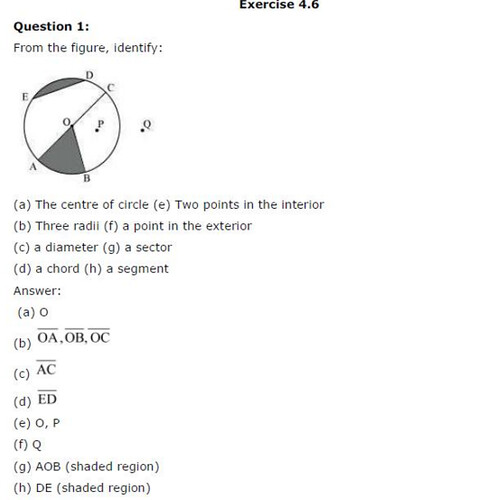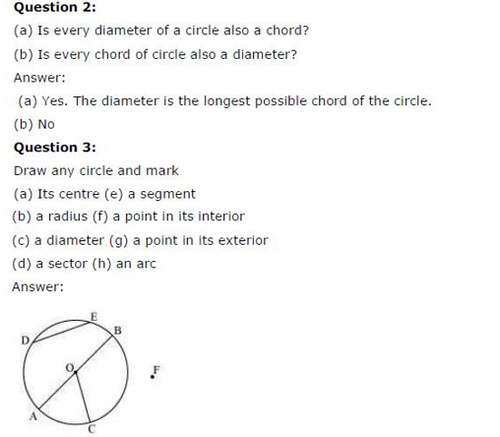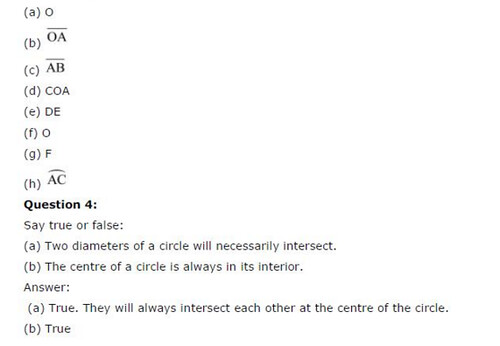NCERT Solutions for Class 6 Maths Chapter 4 Basic Geometrical Ideas
NCERT Solutions for Class 6 Maths Chapter 4 Basic Geometrical Ideas Ex 4.1
Exercise 4.1
Ex 4.1 Class 6 Maths Question 1.
Use the figure to name:
(a) Five points
(b) A line
(c) Four rays
(d) Five line segments
Solution:
(a) Five points are: O, B, C, E and D
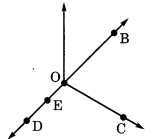
(b) Name of the line is DB←→ or BD←→.
(c) Four rays are: OC−→−, OB−→−, OE−→− and OD−→−
(d) Five line segments are:
OE¯¯¯¯¯¯¯¯, ED¯¯¯¯¯¯¯¯, OD¯¯¯¯¯¯¯¯, OB¯¯¯¯¯¯¯¯ and EB¯¯¯¯¯¯¯¯.
Ex 4.1 Class 6 Maths Question 2.
Name the line given in all possible (twelve) ways, choosing only two letters at a times from the four given.
![]()
Solution:
The given lines can be named as follows:
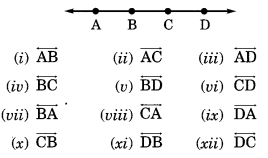
Ex 4.1 Class 6 Maths Question 3.
Use the figure to name:
(a) Line containing point E.
(b) Line passing through A.
(c) Line on which 0 lies.
(d) Two pairs of intersecting lines.
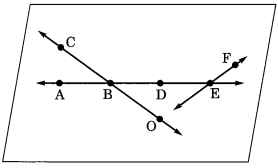
Solution:
(a) EF←→
(b) AE←→
(c) BC←→ or BO←→
(d) CO←→ or AE←→ or AE←→ or EF←→
Ex 4.1 Class 6 Maths Question 4.
How many lines can pass through
(a) one given point?
(b) two given points?
Solution:
(a) Infinitely many lines can pass through a given points.
(b) Only one line can pass through two given points.
Ex 4.1 Class 6 Maths Question 5.
Draw a rough figure and label suitably in each of the following cases:
(a) Point P lies on AB¯¯¯¯¯¯¯¯.
(b) XY←→ and PQ←→ intersect at M.
(c) Line L contains E and F but not D.
(d) OP←→ and OQ←→ meet at O.
Solution:
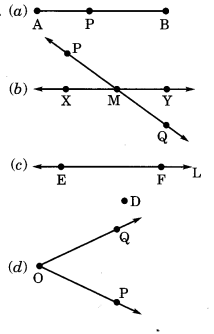
Ex 4.1 Class 6 Maths Question 6.
Consider the following figure of line MN. Say whether following statements are true or false in context of the given figure.
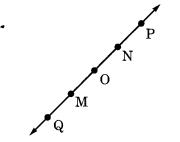
(a) Q, M, O, N, P are points on the line MN←→−.
(b) M, O, N are points on a line segment MN¯¯¯¯¯¯¯¯¯¯.
(c) M and N are end points of line segment MN¯¯¯¯¯¯¯¯¯¯.
(d) O and N are end points of line segment OP¯¯¯¯¯¯¯¯ .
(e) M is one of the end points of line segment QO¯¯¯¯¯¯¯¯.
(f) M is point on ray OP−→−.
(g) Ray OP←→ is different from ray QP−→−.
(h) Ray OP←→ is same as ray OM−→− .
(i) Ray OM−→− is not opposite to ray OP←→.
(j) O is not an initial point of OP←→.
(k) N is the initial point of NP−→− and NM−→−.
Solution:
(a) True
(b) True
(c) True
(d) False
(e) False
(f) False
(g) True
(h) False
(i) False
(j) False
(k) True
NCERT Solutions for Class 6 Maths Chapter 4 Basic Geometrical Ideas Ex 4.2
Exercise 4.2
Ex 4.2 Class 6 Maths Question 1.
Classify the following curves as (i) open or (ii) closed.
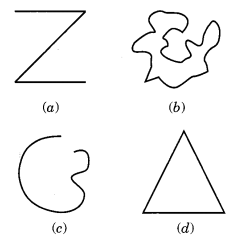
Solution:
(a) Open curve
(b) Closed curve
(c) Open curve
(d) Closed curve
Ex 4.2 Class 6 Maths Question 2.
Draw rough diagrams to illustrate the following:
(a) Open curve
(b) Closed curve
Solution:

Ex 4.2 Class 6 Maths Question 3.
Draw any polygon and shade
Solution:
ABCD is the required polygon whose interior region is shaded.

Ex 4.2 Class 6 Maths Question 4.
Consider the given figure and answer the questions.
(a) Is it a curve?
(b) Is it closed?
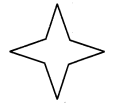
Solution:
(a) Yes, it is a curve.
(b) Yes, it is closed curve.
Ex 4.2 Class 6 Maths Question 5.
Illustrate, if possible, each one of the following with a rough diagram:
(a) A closed curve that is not a polygon.
(b) An open curve made up entirely of line segments.
(c) A polygon with two sides.
Solution:
(a) Required closed curve is a circle.
(b) ABCD is an open curve made up of the line segments AB¯¯¯¯¯¯¯¯, BC¯¯¯¯¯¯¯¯ and CD¯¯¯¯¯¯¯¯ .
(c) A polygon with two sides is not possible.
IMG
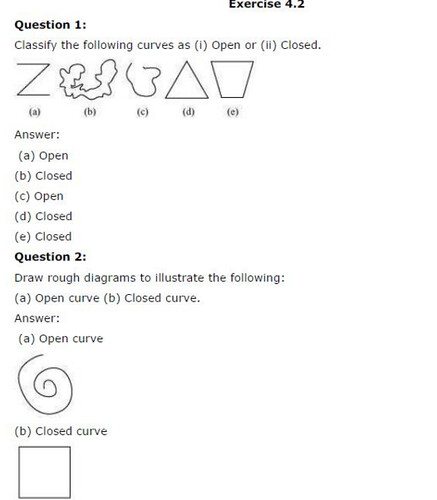
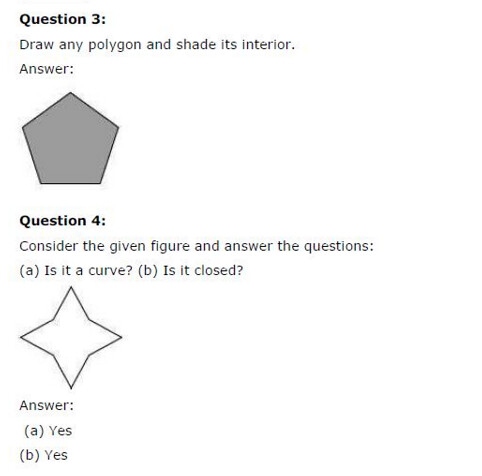
NCERT Solutions for Class 6 Maths Chapter 4 Basic Geometrical Ideas Ex 4.3
Exercise 4.3
Ex 4.3 Class 6 Maths Question 1.
Name the angles in the given figure.
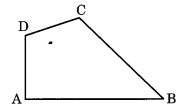
Solution:
The angles are:
(i) ∠A or ∠DAB
(ii) ∠B or ∠CBA
(iii) ∠C or ∠DCB
(iv) ∠D or ∠ADC.
Ex 4.3 Class 6 Maths Question 2.
In the given diagram, name the point(s):
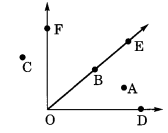
(a) In the interior of ∠DOE
(b) In the exterior of ∠EOF
(c) On ∠EOF
Solution:
(a) A is the point in the interior ∠DOE.
(b) C is the point in the exterior ∠EOF.
(c) B is the point on ∠EOF.
Ex 4.3 Class 6 Maths Question 3.
Draw rough diagrams of two angles such that they have
(а) one point in common.
(b) two points in common.
(c) three points in common.
(d) four points in common.
(e) One ray in common.
Solution:
(a) In figure (a), O is the common point of ∠AOB and ∠COB.
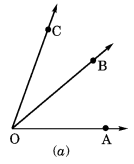
(b) In figure (b), O and P are the common points in ∠SOA and ∠OPQ.
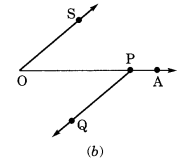
(c) Such a diagram is not possible.
(d) Such a diagram is not possible.
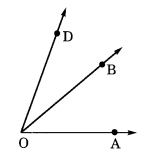
(e) OB−→− is the common ray of ∠AOB and ∠DOB.
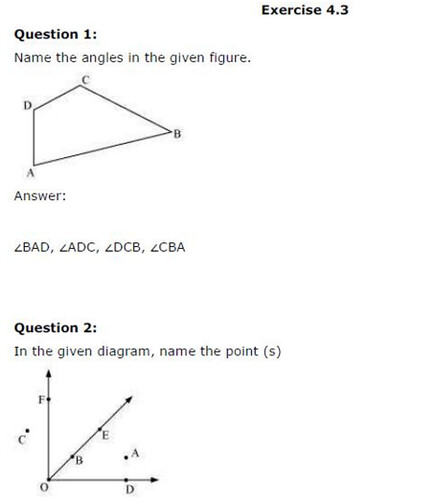
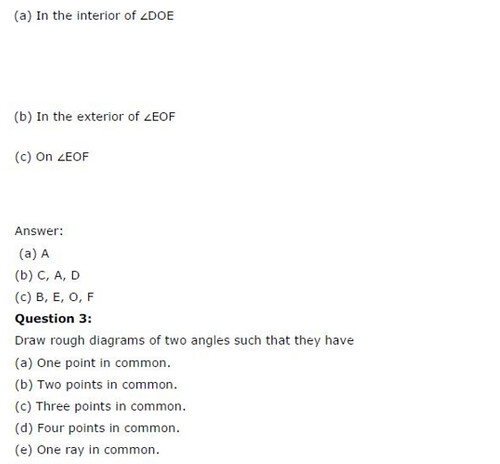
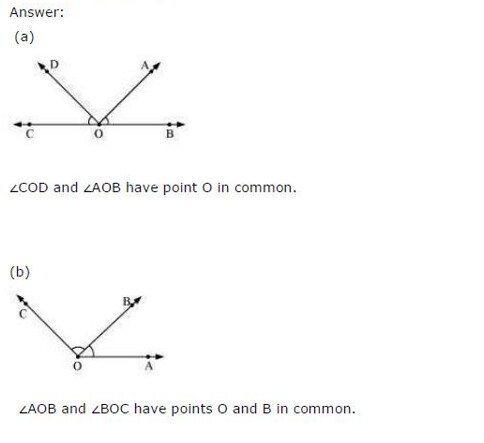
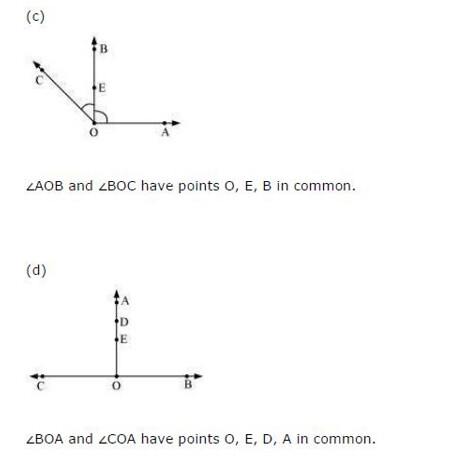
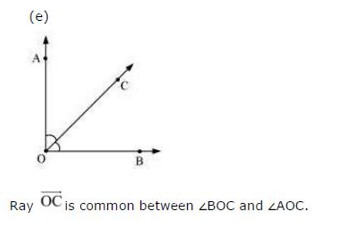
NCERT Solutions for Class 6 Maths Chapter 4 Basic Geometrical Ideas Ex 4.4
Exercise 4.4
Ex 4.4 Class 6 Maths Question 1.
Draw a rough sketch of a triangle ABC. Mark a point P in its interior and a point Q in its exterior. Is the point A in its exterior or in its interior?
Solution:
Triangle ABC is the given triangle.
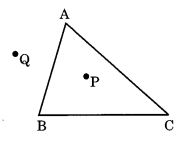
P is in the interior of ∆ABC.
Q is in the exterior of ∆ABC.
A is neither in the exterior nor in the interior.
Ex 4.4 Class 6 Maths Question 2.
(a) Identify three triangles in the figure.
(6) Write the names of seven angles.
(c) Write the names of six line segments.
(d) Which two triangles have ∠B as common?
Solution:
(a) Three triangles are: ∆ABC, ∆ABD and ∆ADC.
(b) (i) ∠ABC
(ii) ∠ADB
(iii) ∠BAD
(iv) ∠ADC
(v) ∠ACD
(vi) ∠DAC
(vii) ∠BAC.
(c) AB¯¯¯¯¯¯¯¯ , BD¯¯¯¯¯¯¯¯ , AD¯¯¯¯¯¯¯¯ , AC¯¯¯¯¯¯¯¯ , DC¯¯¯¯¯¯¯¯ , BC¯¯¯¯¯¯¯¯
(c) ∆ABC and ∆ABD have ∠B as common.
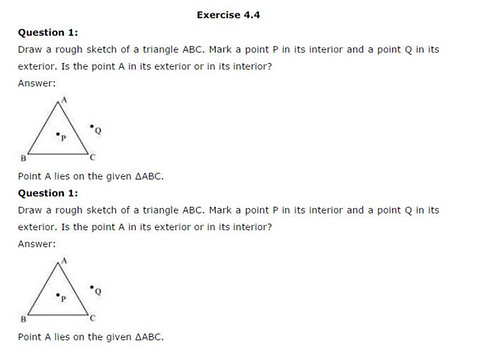
NCERT Solutions for Class 6 Maths Chapter 4 Basic Geometrical Ideas Ex 4.5
Exercise 4.5
Ex 4.5 Class 6 Maths Question 1.
Draw a rough sketch of a quadrilateral PQRS. Draw its diagonals. Name them. Is the meeting point of the diagonals in the interior or exterior of the quadrilateral?
Solution:
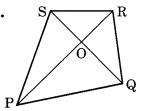
(i) We have a quadrilateral PQRS.
(ii) PR and QS are its two diagonals.
(iii) O is the meeting point of the diagonals PR and QS which is in the interior of the quadrilateral.
Ex 4.5 Class 6 Maths Question 2.
Draw a rough sketch of a quadrilateral KLMN. State:
(a) two pairs of opposite sides
(b) two pairs of opposite angles
(c) two pairs of adjacent sides
(d) two pairs of adjacent angles.
Solution:
KLMN is the given quadrilateral.
(a) KL¯¯¯¯¯¯¯¯ , NM¯¯¯¯¯¯¯¯¯¯ and KN¯¯¯¯¯¯¯¯¯ , LM¯¯¯¯¯¯¯¯¯ are the pairs of opposite sides.
(b) ∠K and ∠M, ∠L and ∠N are the pairs of opposite angles.
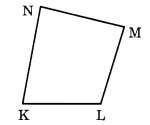
(c) KL¯¯¯¯¯¯¯¯ and KN¯¯¯¯¯¯¯¯¯, NM¯¯¯¯¯¯¯¯¯¯ and ML¯¯¯¯¯¯¯¯¯ are the pairs of adjacent sides.
(d) ∠K and ∠L, ∠N and ∠M are the pairs of adjacent angles.
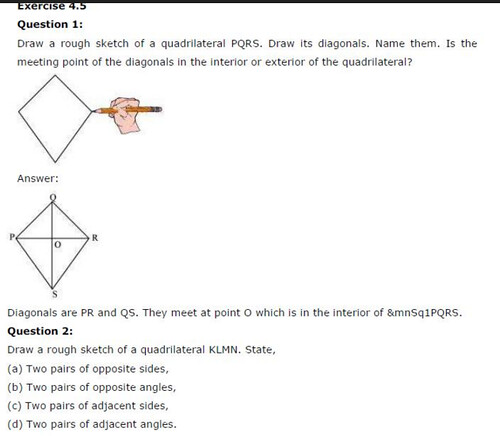
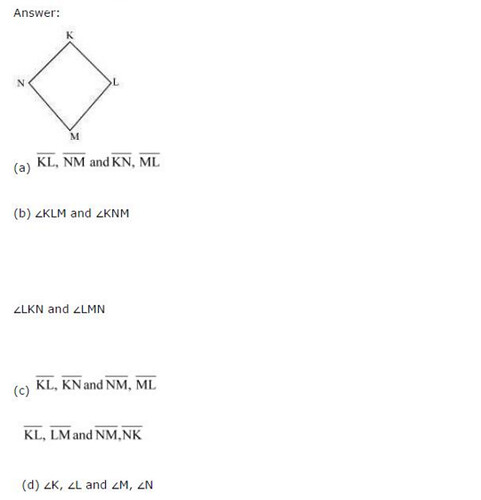
NCERT Solutions for Class 6 Maths Chapter 4 Basic Geometrical Ideas Ex 4.6
Exercise 4.6
Ex 4.6 Class 6 Maths Question 1.
From the figure, identify:
(a) the centre of circle
(b) three radii
(c) a diameter
(d) a chord
(e) two points in the interior
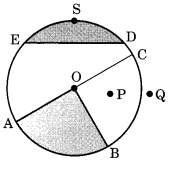
(f) a point in the exterior
(g) a sector
(h) a segment.
Solution:
In the given figure,
(a) O is the centre of the circle.
(b) Three radii of the given circle are OA¯¯¯¯¯¯¯¯ , OB¯¯¯¯¯¯¯¯ and OC¯¯¯¯¯¯¯¯ .
(c) AC¯¯¯¯¯¯¯¯ is a diameter of the circle.
(d) ED¯¯¯¯¯¯¯¯ is a chord of the circle.
(e) O and P are in the interior of the circle.
(f) Q is a point in the exterior of the circle.
(g) OBA is a sector of the circle.
(h) EDSE, the shaded region is a segment of the circle.
Ex 4.6 Class 6 Maths Question 2.
(a) Is every diameter of a circle also a chord?
(b) Is every chord of a circle also a diameter?
Solution:
(a) Yes, every diameter is the longest chord of a circle.
(b) No, every chord is not diameter of a circle.
Ex 4.6 Class 6 Maths Question 3.
Draw any circle and mark
(a) its centre
(b) a radius
(c) a diameter
(d) a sector
(e) a segment
(f) a point in its interior
(g) a point in its exterior
(h) an arc.
Solution:
In the given circle,
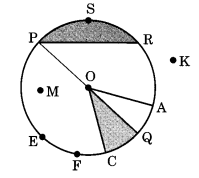
(a) O is the center.
(b) OA¯¯¯¯¯¯¯¯ is a radious.
(c) PQ¯¯¯¯¯¯¯¯ is a diameter.
(d) OQC is a sector (shaded part)
(e) PSR (shaded part) in the segment.
(f) M is in the interior of the circle.
(g) K is in the exterior of the circle.
(h) EF˘ is an arc of the circle.
Ex 4.6 Class 6 Maths Question 4.
Say ‘true’ or ‘false’.
(a) Two diameters of a circle will necessarily intersect.
(b) The centre of a circle is always in its interior.
Solution:
(a) True
(b) True
